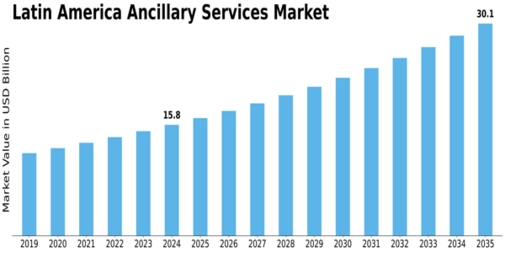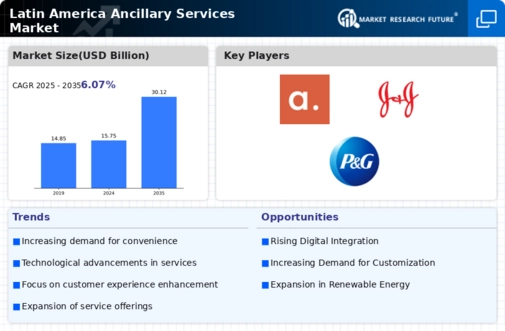Latin America Ancillary Services Size
Latin America Ancillary Services Market Growth Projections and Opportunities
The Latin America ancillary services market is shaped by various factors that influence its growth and development. Firstly, the overall economic conditions and travel trends in the region play a significant role in determining the demand for ancillary services. Factors such as GDP growth, disposable income levels, and tourism trends affect passenger traffic and their willingness to spend on additional services beyond the basic fare.
Secondly, technological advancements and changes in consumer behavior impact the ancillary services market. The rise of digital platforms and mobile apps has transformed how passengers book and manage their travel experience, including ancillary services such as seat upgrades, extra baggage, and in-flight amenities. Airlines and travel companies leverage technology to offer personalized and convenient ancillary services, enhancing the overall passenger experience.
Moreover, airline alliances and partnerships with third-party service providers influence the Latin America ancillary services market. Airlines collaborate with hotels, car rental companies, travel insurance providers, and other partners to offer bundled packages and cross-selling opportunities to passengers. These partnerships expand the range of ancillary services available to travelers and create additional revenue streams for airlines and their partners.
Government regulations and policies also play a role in shaping the ancillary services market in Latin America. Aviation authorities and regulatory bodies impose rules and guidelines regarding the pricing, transparency, and provision of ancillary services to ensure consumer protection and fair competition. Airlines must comply with these regulations while optimizing their ancillary revenue strategies to maximize profitability.
Furthermore, market competition among airlines and travel companies drives innovation and differentiation in ancillary services. Airlines seek to differentiate themselves by offering unique and attractive ancillary services that appeal to passengers and enhance their travel experience. This competitive landscape fosters creativity and innovation, benefiting both passengers and industry stakeholders.
Additionally, macroeconomic factors such as currency fluctuations and inflation rates can impact the affordability and demand for ancillary services. Airlines must adjust their pricing strategies and offerings in response to changing economic conditions to remain competitive in the market.
Consumer preferences and cultural trends also influence the Latin America ancillary services market. Latin American passengers have diverse preferences and expectations when it comes to ancillary services, influenced by factors such as local customs, travel habits, and lifestyle choices. Airlines must tailor their ancillary offerings to cater to these preferences and ensure a relevant and appealing experience for passengers.
Lastly, the impact of external events such as the COVID-19 pandemic has significantly affected the ancillary services market in Latin America. Travel restrictions, reduced passenger traffic, and changes in consumer behavior have led to a decline in ancillary revenue for airlines and travel companies. However, as travel gradually resumes and passenger confidence improves, there are opportunities for recovery and growth in the ancillary services market, driven by pent-up demand and evolving consumer preferences.







Leave a Comment